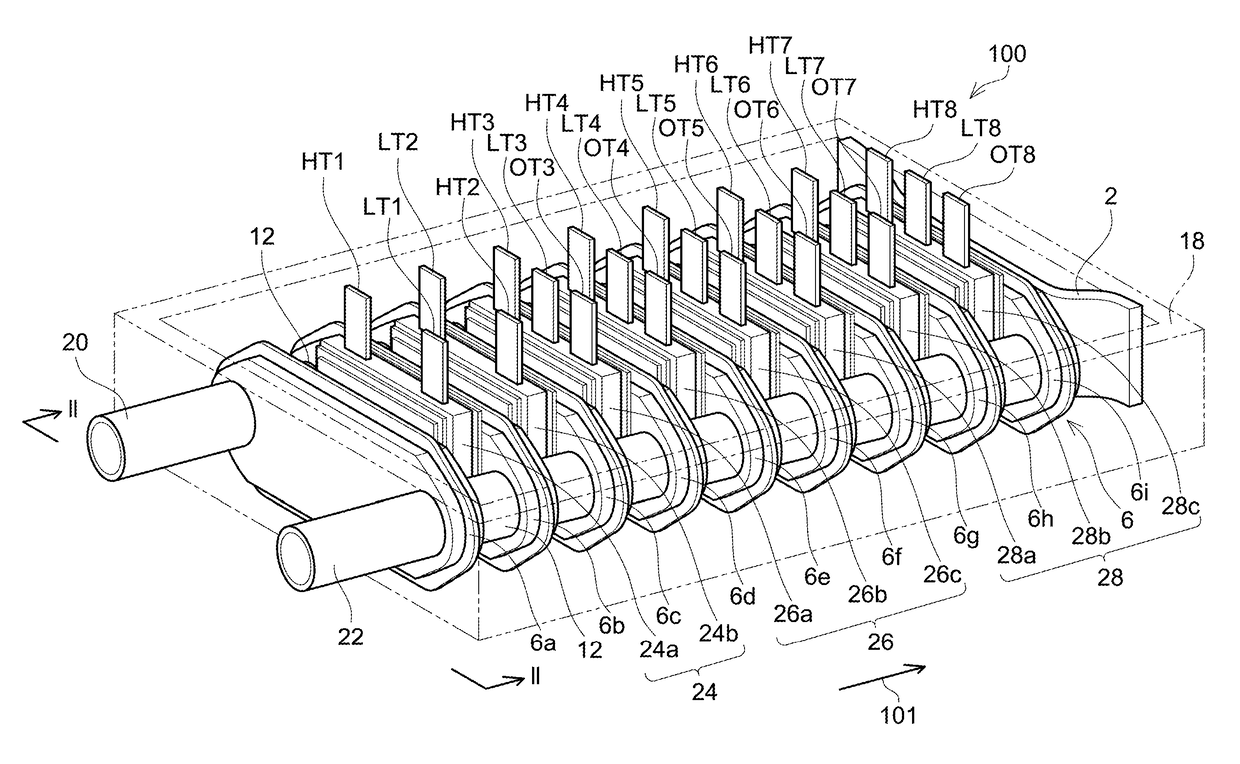Power converter
a power converter and converter technology, applied in the field of power converters, can solve the problems of surge problem becoming significant for the inability to use a 2-in-1 semiconductor device, and the surge problem so as to prevent the surge of a 1-in-1 semiconductor device, prevent the surge voltage, boost or reduce the effect of voltag
- Summary
- Abstract
- Description
- Claims
- Application Information
AI Technical Summary
Benefits of technology
Problems solved by technology
Method used
Image
Examples
first embodiment
[0028]Referring to FIGS. 1 to 3, a power converter 100 will be described. In FIG. 1, a housing 18 of the power converter 100 is indicated by imaginary lines, and in FIG. 2, only a portion of the housing 18 is illustrated. In the following descriptions, alphabets in reference numerals of components may be omitted when the components have a substantially same function.
[0029]As illustrated in FIGS. 1 and 2, the power converter 100 has a voltage converter circuit 24, a first inverter circuit 26, and a second inverter circuit 28. As illustrated in FIG. 3, the power converter 100 is used for driving two motors 50 and 52. The motors 50 and 52 are used for driving an electric vehicle, for instance. Specifically, the power converter 100 includes the voltage converter circuit 24 which is a chopper type and boosts a voltage of a power supply 56, the first inverter circuit 26 which converts a direct current power after the boosting to an alternate current power, and the second inverter circuit ...
second embodiment
[0055]Referring to FIGS. 5 to 7, a power converter 200 will be described. The power converter 200 is a modification of the power converter 100, and a voltage converter circuit 224 differs in structure from the voltage converter circuit 24 of the power converter 100. The first inverter circuit 26 and the second inverter circuit 28 have the same structure as those of the power converter 100. Thus, in FIGS. 6 and 7, only the voltage converter circuit 224 is illustrated, and the inverter circuits are omitted. The same components of the power converter 200 as those of the power converter 100 are indicated by the same reference numerals or reference numerals having identical last two digits, and the description thereof may hereinafter be omitted.
[0056]The voltage converter circuit 224 has semiconductor devices 24a and 24b, and a semiconductor device 24c. The semiconductor device 24c has substantially a same structure as those of the semiconductor devices 24a and 24b. As illustrated in FIG...
third embodiment
[0061]Referring to FIG. 8, a power converter 300 will be described. The power converter 300 is a modification of the power converters 100 and 200, and a voltage converter circuit 324 differs in structure from the voltage converter circuit 24 of the power converter 100 and the voltage converter circuit 224 of the power converter 200. Inverter circuits in the power converter 300 have the same structure as those of the power converters 100 and 200. Thus, in FIG. 8, only the voltage converter circuit 324 is illustrated, and the inverter circuits are omitted. The same components of the power converter 300 as those of the power converters 100 and 200 are indicated by the same reference numerals or reference numerals having identical last two digits, and the description thereof may hereinafter be omitted. FIG. 8 illustrates only a circuit diagram of the voltage converter circuit 324.
[0062]As illustrated in FIG. 8, the voltage converter circuit 324 has one upper arm circuit 324a, and three ...
PUM
 Login to View More
Login to View More Abstract
Description
Claims
Application Information
 Login to View More
Login to View More - R&D
- Intellectual Property
- Life Sciences
- Materials
- Tech Scout
- Unparalleled Data Quality
- Higher Quality Content
- 60% Fewer Hallucinations
Browse by: Latest US Patents, China's latest patents, Technical Efficacy Thesaurus, Application Domain, Technology Topic, Popular Technical Reports.
© 2025 PatSnap. All rights reserved.Legal|Privacy policy|Modern Slavery Act Transparency Statement|Sitemap|About US| Contact US: help@patsnap.com



